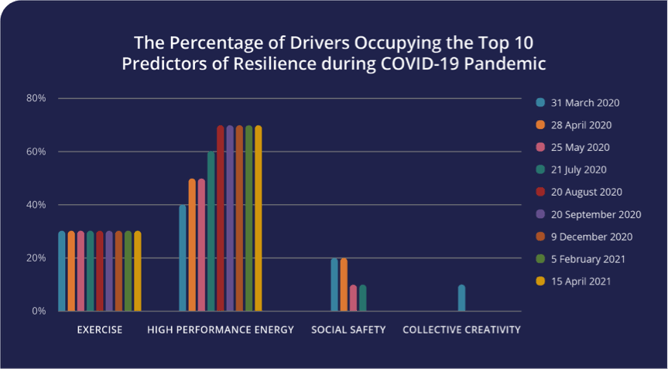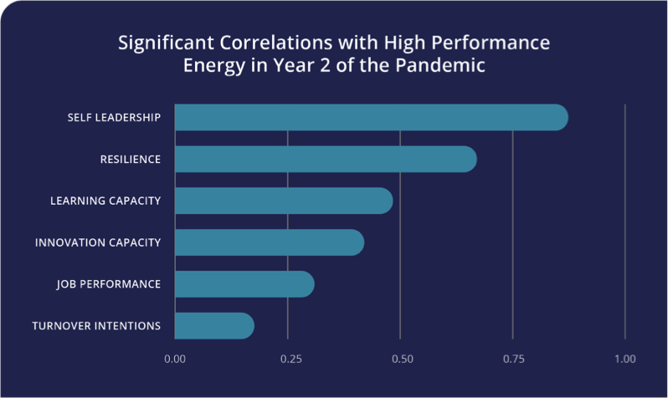Profound implications for self-and collective leadership:
The phrases ‘the sky is the limit’, ‘everything is possible’, and ‘if you dream it, you can do it’ are important because they motivate; they change our beliefs and contribute to our positive mindsets. But their message doesn’t apply to the energy that our brain-body systems produce.
We produce energy in a finite way. We ingest fuel in the form of food, we breathe in oxygen, which burns the fuel in every bodily cell, and this combustion produces energy in the form of heat and a product, called ATP, that makes the cells work – to make the neural circuits in the brain fire, to make us think, feel, innovate, decide, act and interact. Of course, we release the by-products of this equation by breathing out carbon dioxide and letting out water, and so the brain-body machine takes complete care of this incredible combustion process.
You cannot produce an infinite amount of energy. It is not only finite but used in set proportions. The brain uses an astonishing 20% of the available energy, even though it makes up only 2% of our total body mass.
Why is the concept of finite energy so crucial for business leadership?
Energy is currency
The whole brain-body system is driven by the following ground rule: optimize the yield for the energy assigned to the task. Think about learning: using knowledge alone requires much more energy than using skills, which again requires much more energy than using expertise to get the same job done. Physically, the brain structured itself over time to get more done for less effort. To be in a neuronal flow state requires the least amount of energy for the highest yield – so that the task becomes ‘effortless.’ The more we can do with our finite energy, the higher our performance capacity.
Finite energy underpins self-leadership
Self-leadership can be viewed as the individual capacity to assign the right amount of energy to the right tasks. To be good self-leaders, we need to make an accurate assessment of the importance of every daily challenge – an assessment that we call an appropriated value-tagging system. We then must assign the minimum required amount of energy to the most critical challenges for the best yield. Of course, assessing our skillsets and the ones needed to overcome the challenge at hand also forms part of the equation. See how the whole process is governed by the economics of human capacity.
Finite energy drives systems-behavior implications for collective leadership
We naturally aggregate into groups to enhance our chances to stay alive, survive, and thrive in life. We connect; we bond; we stick together. Connecting requires energy. Once we optimally connect and become collectively innovative, we have a much better yield for the energy we assigned to the task, than when every individual group member works on the same task alone. The collective output is bigger than the sum of all the individual outputs. A new living entity arises when the group functions optimally as a united collective. Plugging into this collective enhances our Resilience and capacity for High Performance.
Great leadership is required to ensure the group functions as a new living whole. Leaders need to understand how important, for example, a sense of belonging, entrustment (bonding), cognitive empathy (thinking in another’s shoes) and affective empathy (feeling in another’s shoes) are to help the group synchronize. By synchronize, we mean enabling the individual brains in a team to electrically align their brain cell activity. The most effective teams demonstrate the highest yield for the finite energy collectively assigned to the task.
Energy is finite but still needs to be optimized
It is critical for leaders of ‘self and team’ to understand this concept well, especially what characteristics affect the amount of finite energy available to assign to the task. In science, we have seen how chronic stress both blocks and continuously leaks energy, even to the point of burnout. We know that addictions, destructive habits, and negative, intrusive thought patterns act as energy blockers, reducing the Resilience and High Performance Readiness of individuals and teams. In contrast, the great news is that optimism, enthusiasm, gratitude, humor, and curiosity act as energy boosters. Consciously cultivating these characteristics daily goes a long way towards giving us the High Performance Energy we so desperately and globally require.
Our Neurozone® data demonstrates the importance of High Performance Energy in COVID-19
The Neurozone® High Performance Code, developed over the last decade using collective business leaders’ data, consists of 65 behaviors, emotional states, and cognitive states identified and verified as predictive of Resilience and High Performance Readiness. At Neurozone, we have been using the High Performance Code global data of 1489 of leaders to define the top predictors of Resilience and High Performance Readiness during the COVID-19 pandemic. Before COVID-19, we saw quite a stable Code, with optimism being the number one predictor, reducing negative thought patterns being the next highest predictor, and solving problems using the generic part techniques taking third place.
When COVID covered the globe in 2020, humanity’s extreme environmental changes led to significant adaptations of the behavioral Code. We now saw that exercise duration and exercise diversity took the number one and two spots, respectively, with avoiding destructive habits moving into third place. What is equally fascinating is that the High Performance Energy drivers increasingly filled the top 10 predictor positions, and after 4 months have now stabilized as constituting 70% of the top 10 predictors.
The graph below illustrates this significant dynamic shift. Leaders must appreciate the dynamic way the different behaviors, emotional states and cognitive states continuously re-prioritize themselves to optimize Resilience as the equifinal endpoint.

High Performance Energy correlates strongly with self-leadership and Resilience, especially.
Looking at the data of 541 leaders globally in Year 2 of the Covid Pandemic, we saw a very strong and significant correlation between High Performance Energy, self-leadership and Resilience in the dataset:

The significance of this relationship cannot be understated as we become increasingly engulfed by the new and consequent ‘mental pandemic’. High Performance Energy may well become one of the cornerstones of preventing mental disorders in the workplace in 2021. Indeed, human capital leadership should invest in for the best Resilience and High Performance.